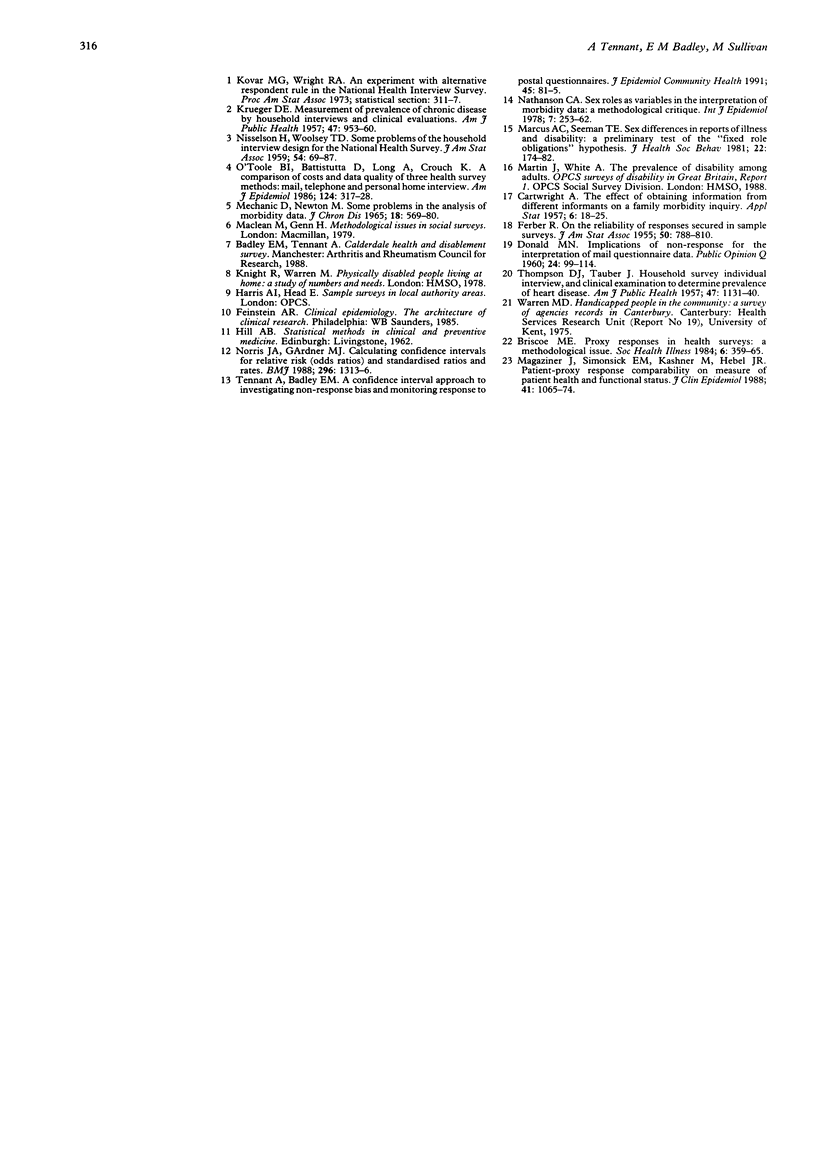Abstract
STUDY OBJECTIVE--The aim was to investigate two possible sources of bias inherent in using a household based postal questionnaire, the "proxy effect", inaccurate reporting about characteristics of others, and the "saliency principle", reporting of only the most salient features. This is of importance in surveys concerned with screening the population to identify individuals with certain characteristics, and so possibly relying on one member of the household to reply on behalf of all others. DESIGN AND SETTING--A two stage survey of disablement in the population was undertaken. A first phase postal questionnaire was sent to 25,168 households in Calderdale, West Yorkshire, England, to ascertain the prevalence of physical disability and of troubles with the joints. The second phase comprised in depth interviews with a sample of individuals identified in the first phase as being disabled. RESPONDENTS--A total of 21,889 postal questionnaires were returned (87%) representing households containing 42,826 people aged 16 years and over. A disproportionately stratified random sample of 950 respondents reporting disability was taken in the second phase. Of these 891 were still available, and 838 (94%) were interviewed. MEASUREMENTS AND MAIN RESULTS--The postal questionnaire found that almost 29% of those who lived "alone" (without another adult) reported some level of disability, compared to only 10% of those who lived with others. The difference remained significant after standardisation. This apparent underreporting or "proxy effect" was present for reporting about disability overall, but not for severe disability (dependence on help of others), which suggests the operation of the "saliency principle". Reporting on joint troubles appeared to be affected by the proxy effect both for any joint problems, and when more than five joints were affected. Analysis of a small set of postal questionnaires from respondents who reported joint problems only at interview and where we could identify who had completed the postal questionnaire supports the hypothesis of a proxy effect; two thirds of the original postal questionnaires had been completed by a proxy. The results were further complicated by an interaction between reporting of disability and joint troubles: the greater the level of disability, the less likely the reporting of joint troubles. CONCLUSIONS--The findings have general implications for studies involving postal household screening questionnaires, and raises additional concerns about those that are multitopic in content. In surveys of symptoms and minor disability, a proxy effect is likely to be operative. This effect is not apparent for obvious and long standing problems such as dependence on others for help. However the interaction between the reporting of disability and joint symptoms carries important implications for the development of multitopic postal screening questionnaires.
Full text
PDF




Selected References
These references are in PubMed. This may not be the complete list of references from this article.
- Briscoe M. E. Research note: proxy responses in health surveys: a methodological issue. Sociol Health Illn. 1984 Nov;6(3):359–365. doi: 10.1111/1467-9566.ep10492006. [DOI] [PubMed] [Google Scholar]
- KRUEGER D. E. Measurement of prevalence of chronic disease by household interviews and clinical evaluations. Am J Public Health Nations Health. 1957 Aug;47(8):953–960. doi: 10.2105/ajph.47.8.953. [DOI] [PMC free article] [PubMed] [Google Scholar]
- MECHANIC D., NEWTON M. SOME PROBLEMS IN THE ANALYSIS OF MORBIDITY DATA. J Chronic Dis. 1965 Jun;18:569–580. doi: 10.1016/0021-9681(65)90078-0. [DOI] [PubMed] [Google Scholar]
- Magaziner J., Simonsick E. M., Kashner T. M., Hebel J. R. Patient-proxy response comparability on measures of patient health and functional status. J Clin Epidemiol. 1988;41(11):1065–1074. doi: 10.1016/0895-4356(88)90076-5. [DOI] [PubMed] [Google Scholar]
- Marcus A. C., Seeman T. E. Sex differences in reports of illness and disability: a preliminary test of the "fixed role obligations" hypothesis. J Health Soc Behav. 1981 Jun;22(2):174–182. [PubMed] [Google Scholar]
- Morris J. A., Gardner M. J. Calculating confidence intervals for relative risks (odds ratios) and standardised ratios and rates. Br Med J (Clin Res Ed) 1988 May 7;296(6632):1313–1316. doi: 10.1136/bmj.296.6632.1313. [DOI] [PMC free article] [PubMed] [Google Scholar]
- Nathanson C. A. Sex roles as variables in the interpretation of morbidity data: a methodological critique. Int J Epidemiol. 1978 Sep;7(3):253–262. doi: 10.1093/ije/7.3.253. [DOI] [PubMed] [Google Scholar]
- O'Toole B. I., Battistutta D., Long A., Crouch K. A comparison of costs and data quality of three health survey methods: mail, telephone and personal home interview. Am J Epidemiol. 1986 Aug;124(2):317–328. doi: 10.1093/oxfordjournals.aje.a114390. [DOI] [PubMed] [Google Scholar]
- THOMPSON D. J., TAUBER J. Household survey, individual interview, and clinical examination to determine prevalance of heart disease. Am J Public Health Nations Health. 1957 Sep;47(9):1131–1140. doi: 10.2105/ajph.47.9.1131. [DOI] [PMC free article] [PubMed] [Google Scholar]


